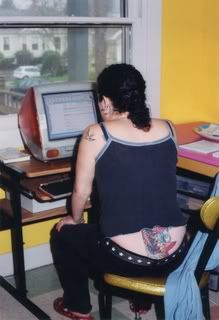Attack on the University, Thursday 2 Nov
From George:
Radio Universidad remains a strong voice at 1:30 pm, but how much longer it will continue is unclear. As the only station still broadcasting for the Popular Assembly movement of Oaxaca, it is a critically important link as well as a source of the most current information on the struggle. This morning an army of troops dressed in PFP uniforms began the frontal assault on the University enclave, called University City, where the station is located. This army looks like a mass of mostly grunts, young guys in their late teens and early twenties, surely drafted by economic necessity into the military ranks.
This morning we heard that the PFP was going to invade Ciudad Universidad on the grounds that there were reported to be firearms there. That's a typical pretext the police use. It's easy enough to get some corrupt state official or PRI-affiliated thug to file a denunciation that firearms or other illegal possessions are in a particular location. Radio Universidad was calling for citizens to come to protect the university, with a great sense of urgency. A friend dropped me off a few blocks from the Cinco Senores intersection, which was blocked on all sides by the PFP. As usual, I was able to circle the blocked intersection on a few side streets, and soon was 'inside' on Avenida Universidad in a mass of people, most facing the lines of shield-equipped PFP troops.
Many in the dense crowd were busy photographing and videotaping the then-still-peaceful confrontation, several of them perched atop a burned-out VW-bug. Some people on a raised platform with a loudspeaker were telling the troops that they were the same as the protestors and shouldn't have been sent to Oaxaca. The PFP lines stood inert, as trained. Several older women in the crowd, right at the front, not more than a foot or two from the plastic shields facing them, forcefully told the troops right in front of them that they are citizens, without arms, capable of running their own lives, and the PFP should leave Oaxaca.
By about 11:30 I started south. After the first barricade, which was north of university property, students were passing pieces of split wood through the barred fence from the university grounds to others on the street side with shopping carts. They use the wood for fires at the barricades. Suddenly an alert spread that an attack was imminent at the south end of Avenida Universidad, and people streamed past me, leaving, I supposed, a smaller crowd at the north intersection. The shopping carts barrelled by, along with people with cameras, many folks adjusting their bandanas getting ready for tear gas. Apparently the PFP, who had been massed at the Plaza del Valle end of the road, began advancing in a solid front, and the fireworks began. From the distance I saw clouds of smoke and/or gas and the wobbly arched paths of the home-made rockets launched towards the police, which left a trace of white smoke as they streaked across the space between the protestors and the PFP forces.
When one of the projectiles hit the ground and burst into flame in front of the first line of troops a wave of adrenaline swept the protestors, many of whom ran forward and hurled rocks at the police. I've written a lot about the teachers and APPO maintaining a militant but non-violent struggle, which I remain concvinced is correct. But this was a different matter: this was people trying to protect their own turf from being invaded by lethally-armed forces, and there's no way the attempted defense could be described as non-violent. Had the police been ordered to shoot, it could have been a massacre. All that can be said is that the imbalance of power was incomparably in favor of the police; had it been used, it would have been overwhelming.
Most of the defenders were younger men. But not all. Their major weapon was a stream of rocks. In addition to their homemade incendiary rockets they may also have had some molotov cocktails. As the police shot tear gas canisters and began a slow step-by-step advance, I headed back a ways and entered the university athletic fields, located on the west side of the avenida behind a fence, and then came forward again, close to but separated from the exchange. Not, however, separated from the tear gas by the chain-link fence. People were taking large rocks and smashing them against other rocks on the ground to break them up into sizes suitable for hurling a considerable distance. Their courage and determination not to yield to the PFP was incredible. I've never before seen anything close to it.
Finally I decided to head back to make a report. Back on the Avenida some distance from the front line, I saw an older man picking up and 'bowling' rocks to be used in the defense along the road towards the actual combatants. I expected that it would not be very long before the PFP got into the Ciudad Universidad and captured and silenced Radio Universidad. But I was wrong. Things were still at a standoff at the north intersection, and I made my way out by the same roundabout route I'd used earlier.
It's 8:40 pm and Radio Universidad is still alive. Don't know what will happen later tonight or tomorrow. It appears that the PFP were driven back. The Oaxaquenos really believe that Los pueblos unidos, jamas sera vencidos (The people united will never be defeated). I hope to hell they're right.
Radio Universidad remains a strong voice at 1:30 pm, but how much longer it will continue is unclear. As the only station still broadcasting for the Popular Assembly movement of Oaxaca, it is a critically important link as well as a source of the most current information on the struggle. This morning an army of troops dressed in PFP uniforms began the frontal assault on the University enclave, called University City, where the station is located. This army looks like a mass of mostly grunts, young guys in their late teens and early twenties, surely drafted by economic necessity into the military ranks.
This morning we heard that the PFP was going to invade Ciudad Universidad on the grounds that there were reported to be firearms there. That's a typical pretext the police use. It's easy enough to get some corrupt state official or PRI-affiliated thug to file a denunciation that firearms or other illegal possessions are in a particular location. Radio Universidad was calling for citizens to come to protect the university, with a great sense of urgency. A friend dropped me off a few blocks from the Cinco Senores intersection, which was blocked on all sides by the PFP. As usual, I was able to circle the blocked intersection on a few side streets, and soon was 'inside' on Avenida Universidad in a mass of people, most facing the lines of shield-equipped PFP troops.
Many in the dense crowd were busy photographing and videotaping the then-still-peaceful confrontation, several of them perched atop a burned-out VW-bug. Some people on a raised platform with a loudspeaker were telling the troops that they were the same as the protestors and shouldn't have been sent to Oaxaca. The PFP lines stood inert, as trained. Several older women in the crowd, right at the front, not more than a foot or two from the plastic shields facing them, forcefully told the troops right in front of them that they are citizens, without arms, capable of running their own lives, and the PFP should leave Oaxaca.
By about 11:30 I started south. After the first barricade, which was north of university property, students were passing pieces of split wood through the barred fence from the university grounds to others on the street side with shopping carts. They use the wood for fires at the barricades. Suddenly an alert spread that an attack was imminent at the south end of Avenida Universidad, and people streamed past me, leaving, I supposed, a smaller crowd at the north intersection. The shopping carts barrelled by, along with people with cameras, many folks adjusting their bandanas getting ready for tear gas. Apparently the PFP, who had been massed at the Plaza del Valle end of the road, began advancing in a solid front, and the fireworks began. From the distance I saw clouds of smoke and/or gas and the wobbly arched paths of the home-made rockets launched towards the police, which left a trace of white smoke as they streaked across the space between the protestors and the PFP forces.
When one of the projectiles hit the ground and burst into flame in front of the first line of troops a wave of adrenaline swept the protestors, many of whom ran forward and hurled rocks at the police. I've written a lot about the teachers and APPO maintaining a militant but non-violent struggle, which I remain concvinced is correct. But this was a different matter: this was people trying to protect their own turf from being invaded by lethally-armed forces, and there's no way the attempted defense could be described as non-violent. Had the police been ordered to shoot, it could have been a massacre. All that can be said is that the imbalance of power was incomparably in favor of the police; had it been used, it would have been overwhelming.
Most of the defenders were younger men. But not all. Their major weapon was a stream of rocks. In addition to their homemade incendiary rockets they may also have had some molotov cocktails. As the police shot tear gas canisters and began a slow step-by-step advance, I headed back a ways and entered the university athletic fields, located on the west side of the avenida behind a fence, and then came forward again, close to but separated from the exchange. Not, however, separated from the tear gas by the chain-link fence. People were taking large rocks and smashing them against other rocks on the ground to break them up into sizes suitable for hurling a considerable distance. Their courage and determination not to yield to the PFP was incredible. I've never before seen anything close to it.
Finally I decided to head back to make a report. Back on the Avenida some distance from the front line, I saw an older man picking up and 'bowling' rocks to be used in the defense along the road towards the actual combatants. I expected that it would not be very long before the PFP got into the Ciudad Universidad and captured and silenced Radio Universidad. But I was wrong. Things were still at a standoff at the north intersection, and I made my way out by the same roundabout route I'd used earlier.
It's 8:40 pm and Radio Universidad is still alive. Don't know what will happen later tonight or tomorrow. It appears that the PFP were driven back. The Oaxaquenos really believe that Los pueblos unidos, jamas sera vencidos (The people united will never be defeated). I hope to hell they're right.





0 Comments:
Post a Comment
<< Home